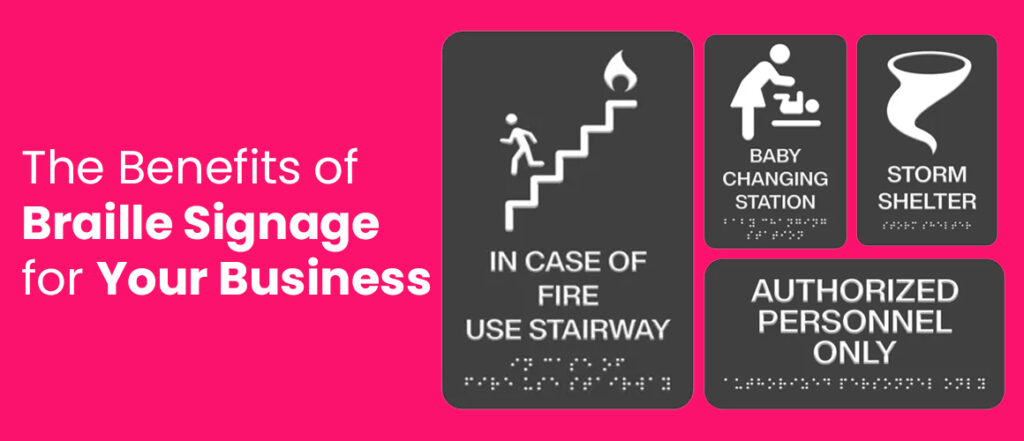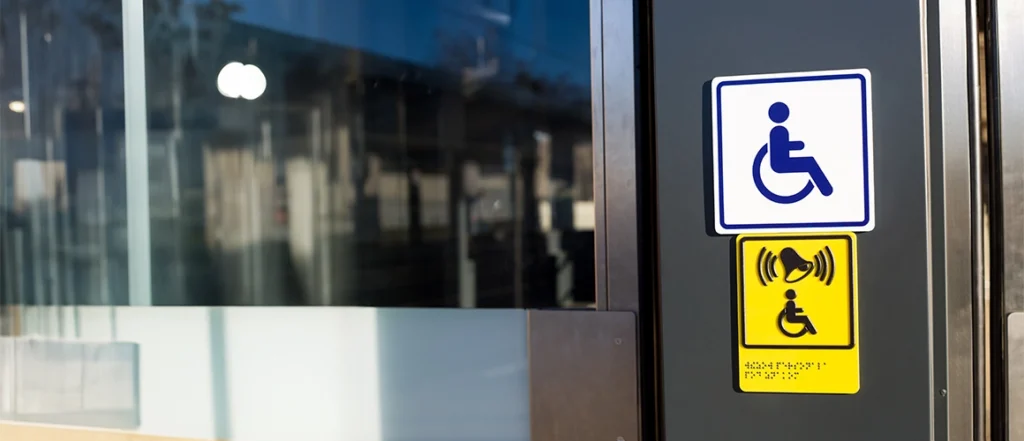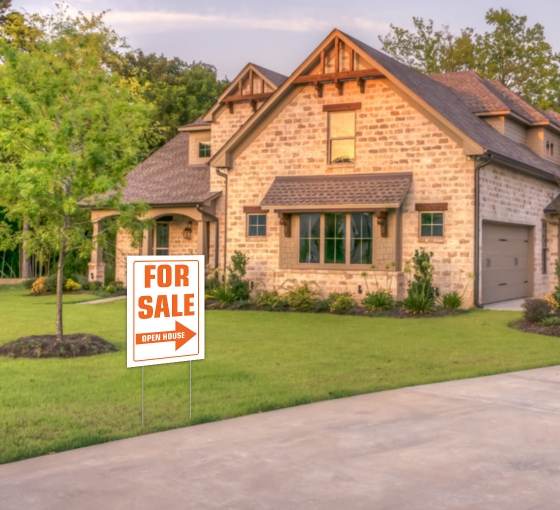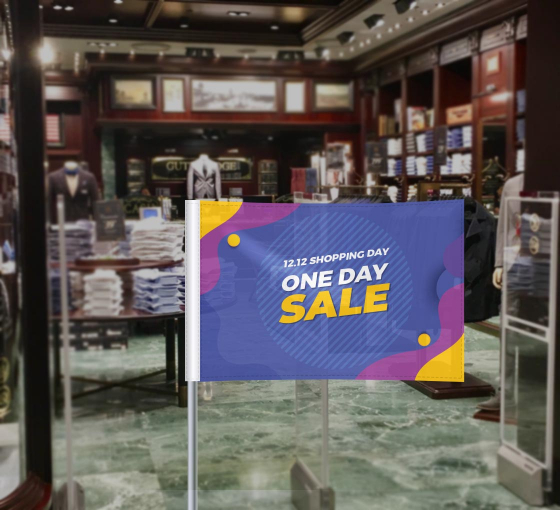In today’s business world, “accessibility” and “inclusivity” have become more than just buzzwords—they are key factors in ensuring customer satisfaction, loyalty and compliance with regulations. One essential aspect of accessibility is Braille signage, which not only helps customers who are visually impaired navigate spaces independently but also improves your brand’s reputation and compliance with legal standards. Implementing the braille signage benefits can have profound impacts on your business and set you apart as a socially responsible brand.

This blog will explore the benefits of improved accessibility with braille signs, how it ensures regulatory compliance, and how it can enhance customer satisfaction. We’ll also share practical tips on how to implement Braille signage effectively and provide real-world examples of companies that have successfully integrated this crucial accessibility feature.
Understanding the Braille Signage
Braille signage uses a tactile writing system of raised dots that represent letters, numbers, and symbols. Created for individuals who are blind or visually impaired, Braille allows these individuals to read signs using their sense of touch. Commonly found in public spaces like elevators, restrooms, and hotel rooms, Braille signage is critical for ensuring that all customers, regardless of their vision abilities, can access information and navigate spaces independently.
1. Improving Accessibility for All Customers
The primary benefit of incorporating braille signs for business is improved accessibility. Around 285 million people globally are visually impaired, and over 39 million are completely blind. For these individuals, being able to independently navigate businesses, stores, and public spaces is an essential aspect of living a fulfilling life.
By adding Braille signage, you make your business more welcoming and accessible to this segment of the population. Imagine a visually impaired customer entering your store and being able to find restrooms, exits, and product sections independently, without needing to ask for help. That’s the kind of seamless experience Braille signage can provide. It’s not just about meeting the needs of a few customers—it’s about ensuring that every customer feels valued and capable in your space.
Practical Example: Hotels and Restaurants
Many modern hotels have adopted Braille signage to help visually impaired guests find their rooms, restrooms, and common areas. Restaurants that incorporate Braille menus make it possible for all diners to independently choose their meals without assistance. The result is a more inclusive, welcoming environment that enhances the overall experience.
2. Compliance with Regulations

Aside from improving accessibility, understanding why braille signage is important is also a regulatory requirement in many countries. In the United States, the Americans with Disabilities Act (ADA) requires businesses, public buildings, and commercial facilities to have Braille signage in specific areas. These include restrooms, exits, elevators, and room numbers.
Failing to meet these requirements can result in penalties, fines, and even lawsuits. Ensuring your business is ADA-compliant not only avoids these risks but also demonstrates your commitment to accessibility and inclusivity.
Practical Example: Retail Stores
Many large retail chains, such as Target, Walmart, and Home Depot, ensure that their facilities are equipped with Braille signage to comply with ADA standards. These businesses also see the added benefit of increased customer satisfaction and loyalty from individuals who value accessibility.
3. Enhancing Customer Satisfaction and Loyalty
Providing Braille signage improves customer satisfaction in a significant way. When your business prioritizes accessibility, you’re showing that you care about all your customers, regardless of their abilities. Visually impaired customers will appreciate the effort you’ve put into making your space more navigable and easier to interact with, which can translate to greater brand loyalty and positive word-of-mouth marketing.
Word spreads quickly in communities where accessibility is a priority, and by making your business more inclusive, you can reach new audiences that may have otherwise overlooked your services. Accessible spaces tend to earn higher customer satisfaction rates, as they create a comfortable and empowering environment for everyone.
Practical Example: Grocery Stores
Many grocery store chains now include Braille signage on aisles, product sections, and even on some packaging. By doing so, they not only enhance the shopping experience for the visually impaired but also attract a broader customer base.
4. Boosting Your Brand’s Reputation

Businesses that actively promote inclusivity often stand out in a positive way. By incorporating Braille signage, you can position your brand as one that values diversity and equal opportunity. Customers notice when businesses go the extra mile to be inclusive, and they are more likely to support brands that align with their values.
Incorporating Braille signage can also enhance your corporate social responsibility (CSR) initiatives. Today’s consumers are more conscious than ever about the ethical practices of the companies they support. When customers see that your business is proactive in making its space accessible to all, it builds trust and respect. Over time, this can translate to higher brand loyalty, stronger community ties, and increased business success.
Practical Tip: Advertise Your Accessibility Initiatives
Once you’ve implemented Braille signage, don’t hesitate to let your customers know about your efforts. Highlight your accessibility initiatives on your website, social media, and even within your store. This can help attract customers who prioritize inclusivity when choosing where to spend their money.
Practical Example: Tech Companies
Apple, for example, is well-known for its commitment to accessibility, not only in its products but also in its retail stores. Apple stores feature Braille signage, wide aisles, and accessible product displays, positioning the brand as a leader in customer inclusivity.
5. Practical Tips for Implementing Braille Signage
Implementing Braille signage requires careful planning, but the benefits far outweigh the effort. Here are some practical tips for getting started:
a. Evaluate Your Space
Walk through your business and identify areas where signage is essential for navigation. This can include restrooms, emergency exits, elevators, and room numbers in hotels or offices.
b. Partner with a Signage Expert
Partner with a signage company well-versed in Braille and ADA compliance. They will assist you in designing, producing, and installing signs that not only meet legal requirements but also elevate the braille signage for customer experience, ensuring accessibility and satisfaction for all visitors.
c. Test for Effectiveness
Once installed, test your Braille signage with individuals who are visually impaired. Their feedback can help you make any necessary adjustments and ensure that your signs are easy to read and navigate.
d. Train Your Staff
Ensure that your staff understands the importance of Braille signage and how it works. This helps create a more inclusive environment and improves the overall customer experience.
6. Positive Impact on Your Brand’s Reputation
Incorporating Braille signage not only improves accessibility and customer satisfaction, but it also boosts your business’s public image. In today’s social landscape, businesses are increasingly judged not only by their products and services but by their ethics and inclusivity.
When your business embraces accessibility initiatives, it builds a reputation as a socially conscious organization that cares about its customers and community. This can set your business apart from competitors, attract more customers, and even lead to positive media coverage.
Conclusion
There are multiple benefits for businesses of all sizes, from improved accessibility and customer satisfaction to enhanced regulatory compliance and boost brand reputation with braille signage. By taking the initiative to implement Braille signage, you’re not only creating an inclusive space for all customers but also positioning your business as a forward-thinking, socially responsible entity. Whether you run a retail store, hotel, office, or restaurant, the impact of making your space accessible through Braille signage is profound and long-lasting.
Written by Best of Signs Editorial Team








































 Posted in
Posted in 








